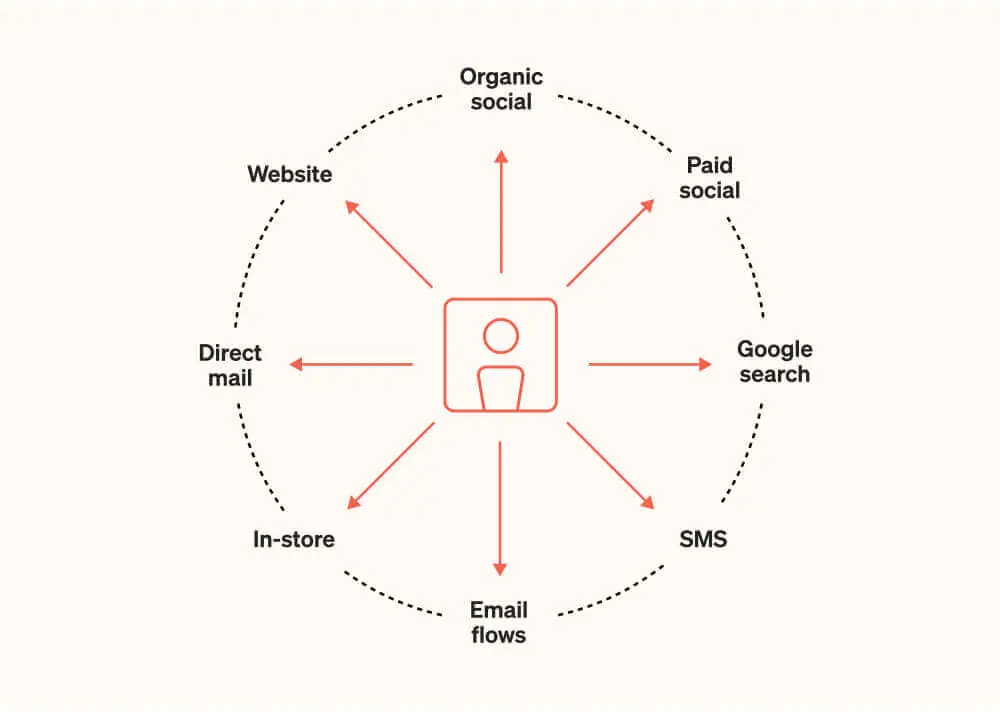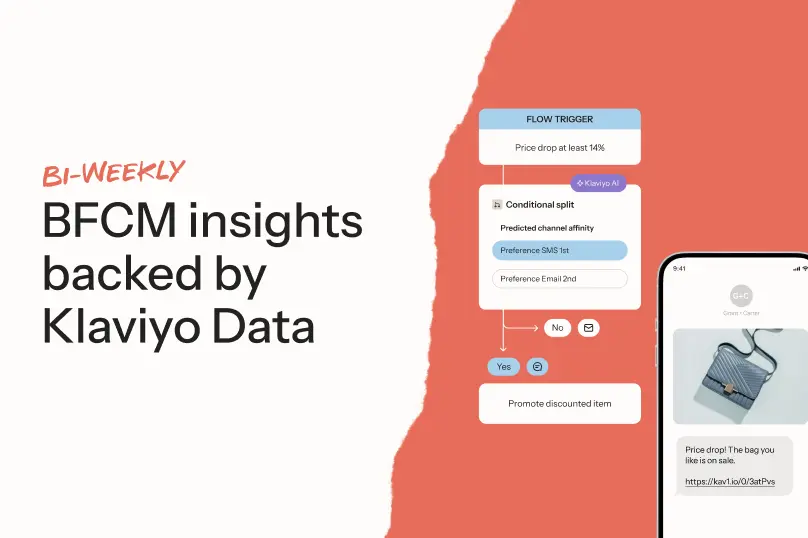Integrated marketing campaigns: How drive engagement and revenue across multiple channels

Integrated campaigns launched across 4+ channels outperform single- or dual-channel campaigns by 300%.
Integrated marketing is the practice of pushing out one cohesive, consistent brand message across multiple channels—and “amplifying a consistent message drives value,” writes Shama Hyder, founder CEO of marketing and PR agency Zen Media, when she cites the above Gartner statistic in Forbes.
If you’ve ever heard of multi-channel or omnichannel marketing—releasing brand messages on multiple channels like email, social media, etc.—integrated marketing is the CRM strategy that sits on top as a binding agent, so that all campaign assets look and feel similar.
This strategy is important because it takes, on average, 6 separate touchpoints for someone to purchase a product—and for the sake of brand recall, you want those touchpoints to feel similar.

Integrated marketing creates clarity for your audience because all parts of a campaign are aligned and unique to your brand. Whether someone is watching a video on YouTube, reading an email, or visiting a physical store, they’re able to follow—and connect with—a thread of consistency throughout.
“The purchasing journey is significantly more fragmented today than it was 10 years ago. People’s lives are simply busier,” explains Tabish Bhimani, principal strategist at Mastrat.
Having an integrated marketing campaign is essentially leading with empathy for customers.
“Because consumers are more distracted, it’s an advantage to use various channels to help remind them of the product they needed when searching for a solution to a problem,” Bhimani adds. “Having an integrated marketing campaign is essentially leading with empathy for customers.”
Integrated marketing vs. omnichannel marketing: what’s the difference?
While integrated marketing is similar to omnichannel marketing, there are some slight nuances that differentiate them from each other.
Integrated marketing is focused on cohesive and consistent messaging: the copy and design used to communicate with the audience. Omnichannel marketing is focused on the customer experience: the purchase and brand experience within the customer journey.
Integrated marketing campaigns work within an omnichannel customer experience to strengthen all the touchpoints that eventually lead to revenue and build brand loyalty over time.
4 major roadblocks to integrated marketing—and how to solve them
Integrated marketing is the future of the marketing field—but this doesn’t mean it’s easy or that everyone at your organization will be on board with it.
“Integrated” also means “aligned”—which is a challenge you may face with your coworkers, your goals, and your tech stack.
Here, we’ll show you how to overcome some of these challenges, before showing you some examples of successful integrated marketing campaign initiatives.
1. Lack of internal alignment
One of the best parts of an integrated marketing campaign is its cohesive narrative. But cohesion requires front-loading internal alignment work to make sure key team members sign off on what that message looks like. Silos are the enemy of integration.
Believe it or not, internal communications are often the biggest roadblock to launching an integrated marketing campaign.
“Believe it or not, internal communications are often the biggest roadblock to launching an integrated marketing campaign,” says Ben Zettler, founder of Zettler Digital.
Especially if your team is large and there are a lot of stakeholders on a campaign, reaching consensus can sometimes take a long time. (You’ll make up that time later, though.)
How to solve this problem
Talk to everyone who has a stake in your integrated marketing campaign. “Meet to discuss your end goal, then execute,” Zettler recommends.
How does each team member communicate with customers? What defines a seamless experience?
Use each person’s responses as a basis for this.
2. No clear goal for campaigns
The glue that holds an integrated marketing campaign together is your goal. Without a clear goal, brand cohesion doesn’t exist.
When an integrated marketing campaign doesn’t start with clear goals, two things can happen: expectations aren’t met, and leadership doesn’t approve future campaigns.
For example, if leadership is expecting a campaign to result in a certain number of new product sales but the goal of the campaign was only to create brand awareness, they may perceive the campaign as a failure.
How to solve this problem
If it’s brand awareness, create a campaign with a call to engagement. If it’s sales, analyze past numbers to determine how an integrated campaign can have an impact.
Attach clear numbers that will provide a concrete answer as to whether your campaign was a success.
Make sure you have the right measurement tools to gauge performance.
3. Limited campaign performance measurement tools
Integrated marketing campaigns are only as good as their ability to follow the customer’s actual journey to purchase. This requires centralizing data on your target audience (potential buyers) and customers in one place.
While many enterprise brands say it’s important to centralize customer data in a customer data platform (CDP), the reality is that many of these brands are also using outdated tech stacks that don’t centralize customer information.
How to solve this problem
Invest in a CDP that:
Increase customer lifetime value (CLTV) with deeper personalization and sophisticated analytics.
Replace redundant tools with a single platform that requires less technical support.
Get faster access to data and give more ownership to marketers who need to execute without help from IT.
Easily connect your tech stack and sync and transform data in real time, at scale.
4. Thinking it’s necessary to go all-in on every channel
“Integrated” doesn’t necessarily mean “invest in all the channels at once, right away.” Depending on your resources, you may only be able to launch your campaign on 2-3 channels to start.
How to solve this problem
Start with what you already have and build on it. Basic channels and tools like sign-up forms, landing pages, and email campaigns are a great foundation for testing. To maximize your chance at success (and protect your business against colossal failure), A/B test emails to see what resonates before adding other channels.
Combining SMS with email, for example, can increase average order value and customer retention metrics (more on this next).
Once your assets are on point, invest in higher-ticket items like out-of-home campaigns with billboards, ad placements on local transportation, TV ads, etc.
“Just try a small step, and then improve over time,” suggests Mat Bingham, head of technology partnerships at Okendo. “Your first campaign may flop, but at least you can learn quickly and move forward.”
Just try a small step, and then improve over time.
3 examples of successful integrated marketing strategies
You’ve likely come across a lot of integrated marketing campaigns run by large companies. But what about small to midsize brands with more limited resources?
Here are some case studies of integrated marketing campaigns that were not run on all the channels—and why the marketing efforts were still effective.
Montirex drives revenue through multi-channel automations
With a young, active audience, sportswear brand Montirex needs to use both email and SMS to create a personal connection with customers and build brand loyalty.
Since switching from Mailchimp to Klaviyo, Montirex has unified their email and SMS marketing under one roof—an improvement Leighton Kearns, trading manager at Montirex, calls “a huge factor in the growth of these channels” that allows the team to “make smarter segmentation decisions.”
The multi-channel journey starts from the first moment a shopper lands on the Montirex website, where they encounter a multi-step sign-up form:

After the website visitor enters their email address and clicks “CLAIM 10% OFF,” they receive their 10% offer in their inbox—but also encounter a second screen of the sign-up form, which asks them for their phone number in exchange for “SMS-only deals.”

By asking shoppers for multiple forms of contact information right off the bat, the Montirex marketing team is able to gather the customer data they need to create seamless multi-channel automations, or flows, that engage with subscribers on their preferred channel at every stage of the sales funnel.
In their abandoned cart flow, for example, Montirex offers a discount to shoppers who abandon a high-value cart, using both email and SMS to remind them to complete their purchase. The strategy works: The flow generates 30% of Klaviyo-attributed revenue.
Sanzo brings offline to online
If Sanzo’s integrated marketing journey seems a bit backwards compared to other DTC brands, it’s because the brand decided to attract an online audience after getting massive brand exposure offline.
Sanzo’s partnership with Disney-owned Marvel started as a celebration of Asian culture in film that ultimately became a co-branded, limited-edition lychee drink collection featuring characters from the film Shang-Chi and the Legend of the Ten Rings on the can.

After the launch of the film, Sanzo saw 6x growth in ecommerce revenue.
At this point, the brand hadn’t been communicating directly with customers, instead relying on relationships through wholesalers. But the new exposure also meant Sanzo’s name became recognizable—so they decided to start emailing potential customers discounts and feedback requests.
Today, Sanzo has a VIP email list for subscribers, who get free shipping and 15% off recurring orders. “We’ll also do some special swag drops for that group,” founder Sandro Roco explains—like giving them early access to Sanzo’s Shang-Chi sparkling water when it dropped.
Jones Road Beauty uses quiz data to fuel a winning BFCM email strategy
People who are overwhelmed by choice are less likely to buy. This is one of the reasons Jones Road Beauty developed a product recommendation quiz to help potential customers narrow down their extensive product line.
Jones Road Beauty’s Miracle Balm Shade Finder quiz helps new shoppers find their preferred look based on their unique skin tone.

Thanks to Klaviyo’s Octane AI integration, the quiz integrates with Jones Road Beauty’s email marketing campaigns by supplying them with customer data they can easily use for smart segmentation.
During BFCM 2023, for example, the marketing team used segmentation data from their quiz to message different audiences differently about a new product drop:
- Prospects who had taken the quiz but never purchased received messaging about trying multiple shades to find their perfect match.
- For VIP repeat buyers, messaging was more about gifting their favorite product, to ensure it felt relevant.
“The ease of creating segments in Klaviyo and spinning up personalized emails plays a big part in our BFCM strategy,” says CMO Cody Plofker. That’s clear: Thanks to strategies like these, 38.4% of Jones Road Beauty’s total BFCM revenue was attributable to Klaviyo in 2023.
Integrated marketing campaign FAQs
What is a real example of integrated marketing?
An example of integrated marketing is Nike’s Breaking2 campaign. Launched in 2016, the campaign followed 3 elite runners Nike selected to run a marathon in under 2 hours, something that had not been done at the time. During the 6 months of the campaign, Nike produced documentary training videos, print ads, media collaborations, billboards, and website features. As a result, the Nike ZoomX Vaporfly 4% was such a coveted shoe that people were paying double for them on eBay. Retailers said they couldn’t keep the shoe in stock for more than a few days at a time.
What is the main goal of integrated marketing?
The main goal of integrated marketing is to create a unified and consistent message across all marketing channels. The idea is to make sure that audiences receive a consistent message no matter how they interact with your brand. This is how integrated marketing helps create a stronger brand identity and improve customer loyalty.
How to create an integrated marketing campaign?
The steps to run a successful integrated marketing campaign depend on multiple factors: industry, the company in question, products, specific channels, audience, and more. But core steps include:
1. Set campaign goals and KPIs.
2. Define target personas.
3. List marketing channels to cover.
4. Build a lead generation plan.
5. Coordinate the campaign launch.
6. Monitor and evaluate results.
7. Optimize the campaign if necessary.
What are the 4 Cs of integrated marketing communication?
The 4 Cs of integrated marketing communication include:
1. Clarity: The message is clear and easy to understand.
2. Consistency: The message is consistent across all channels.
3. Continuity: The message is delivered over a reasonable period of time to see results.
4. Competitiveness: The message is competitive with other messages in the marketplace.

Related content

Learn 5 ways to turn new holiday shoppers into repeat buyers using personalization, seamless returns, targeted outreach, and AI-driven customer experiences.

Learn what to include in your photography style guide to create consistent, on-brand visuals across your B2C marketing channels.

Shopping is about to hit its peak season. But this year’s surge will look different from those before it. Instead of impulsive buying sprees, shoppers are entering the holidays with a more deliberate mindset.